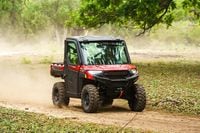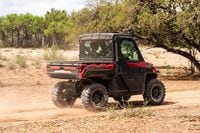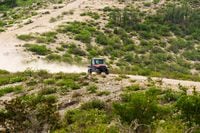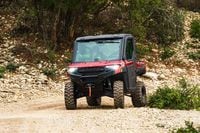When Polaris trotted out news about the 2025 Ranger 1000 and XP 1000, the changes appeared to be little more than “bold new graphics.” Sure, there was some muttering about improved shift feel. A few words about a revised power steering system. But the big news seemed to be aimed at the updated front end designed to put the workhorse in line with machines like the Ranger Kinetic and XD 1500. It turns out that couldn’t be further from the truth. The reality is Polaris has been listening, and the company’s engineers fixed everything we hated about the outgoing model.
We spent a morning running around the south Texas hills in the 2025 Polaris Ranger XP 1000 NorthStar, and while the numbers don’t paint a portrait of a drastically different machine, the details add up to a big step-up. Yes, the 999cc parallel-twin engine is a carryover, and it still produces 82 hp. The bed still hauls 1,000 (600 for California models) pounds and the tow rating remains unchanged at 2,500 pounds. But this Ranger feels like a leap forward. Here’s why:
We’ve spent years complaining about the shift action on Polaris vehicles. The clunky lever and vague gearbox combined to produce a frustrating user experience at best. And after the XD 1500 debuted with its buttery Steel Drive CVT, we knew the company was capable of much, much better. Polaris took some of the lessons learned in developing that transmission and applied it to the rubber-belt gearbox in the Ranger. The “Gen 2″ transmission uses an all-new gearset and better machining, and the result is a massive improvement over the old box.
Shifting isn’t quite as easy as in the big XD 1500, but you can now click the Ranger XP 1000 through its gears with just two fingers. There is no more yanking the lever back and forth in hopes of finding Low or Reverse. Just click the thing in and you’re golden.
All of that means that, for the first time, the Ranger’s transmission feels like it’s worth the asking price.
Polaris made a bunch of noise about “improved steering feel,” but Jenika Bishop, enterprise program manager with the company, told us the update is more than some fresh software. Engineers replaced the electric power steering system with one from an unnamed automotive supplier, and that move decreased steering effort at low speed. You can spin the wheel with one finger at a dead stop. It also means the 2025 Ranger 1000 now has a return-to-center function. Just like in an on-road car or truck, the wheel wants to return straight after a turn.
That, combined with the easier-shifting transmission, means the two points you touch most often when operating the Ranger are now markedly better.
Bishop said one of the other benefits of switching out those steering components is that the move required a new engine control module. That, in turn, required new tuning, which is one reason the 2025 Ranger now uses a 200-hour or 2,000-mile service interval. That’s up from 100 hours or 1,000 miles in the 2024 model, and a huge bump that will save owners big money over the life of the vehicle.
Polaris also focused on improving the machine’s quality inside and out with a stack of small changes. Those range from a better-sealing cab to revised sway bars that reduce interference, squeaks, and rattles. All of that adds up to the first Ranger with a two-year warranty.
Once upon a time, if you bought a Ranger 1000 or XP 1000, you immediately went to the parts catalog for basic pieces like a steel bumper, winch, roof, and bigger tires. All of those are now standard on the 2025 Ranger. All models come with that beefy plow-ready front bumper with a 4,500-pound winch that comes pre-spooled with synthetic line and a magnetic fairlead. That means the winch will automatically shut off once it senses that the hook is close enough, saving you from overloading your winch motor. You also get a poly roof, and XP 1000 models ride on 29-inch tires for the first time.
Keep in mind that the base Ranger XP 1000 still starts at under $21,000, and it’s clear that this machine is a bargain.
Sure, this isn’t a clean-sheet redesign. There is no fancy new engine nor high-tech transmission. But Polaris has very wisely focused its attention on the Ranger’s few weak spots, and the effort has produced the best Ranger we’ve ever tested. Why mess with what works?
Want to stay up to date on the latest UTV Driver news and reviews? Sign up for our weekly newsletter!










/cloudfront-us-east-1.images.arcpublishing.com/octane/XD6N24KU7RCLLNTBNAJ2AW72SY.jpg)






/cloudfront-us-east-1.images.arcpublishing.com/octane/N65KBDC3HNHUXFJMJOWWA37IN4.jpg)
/cloudfront-us-east-1.images.arcpublishing.com/octane/VIWONJHHGZHUPDVLCQGOYK5KUA.jpg)
/cloudfront-us-east-1.images.arcpublishing.com/octane/WUSBK6D3PRH47KTQPHBCHNHEGY.jpg)
/cloudfront-us-east-1.images.arcpublishing.com/octane/XW7O5F3OJJEULDQVUUUMZ2UBPY.jpg)
/cloudfront-us-east-1.images.arcpublishing.com/octane/DKAQTHDEANF5TN6UWAYPC2IYS4.jpg)
/cloudfront-us-east-1.images.arcpublishing.com/octane/B6XEXFJNERAKLP5S2LFP3DQEFM.jpg)
/cloudfront-us-east-1.images.arcpublishing.com/octane/FZJ3DCQM3RCGVNQ6NY5FBMUFBQ.jpg)
/cloudfront-us-east-1.images.arcpublishing.com/octane/VAB524YW5NBSHJTQBUQMLQ5YL4.jpg)
/cloudfront-us-east-1.images.arcpublishing.com/octane/XPOWKJA3YJFOJF4GZJUNNTUEQE.jpg)
/cloudfront-us-east-1.images.arcpublishing.com/octane/GQFAUVAEXJGH3EV2YFJVGBHSIM.jpg)
/cloudfront-us-east-1.images.arcpublishing.com/octane/WTGY4Y56LJC7RDF2T4YRI3YQSI.jpg)
/cloudfront-us-east-1.images.arcpublishing.com/octane/GS72673EPNDNJN3ZAF65HF6EFA.jpg)
/cloudfront-us-east-1.images.arcpublishing.com/octane/XBFWR7DIOJB5RMHBLDYA43OHV4.jpg)
/cloudfront-us-east-1.images.arcpublishing.com/octane/3NY5KEJHBBB7VFMJY2XCEIOKFU.jpg)
/cloudfront-us-east-1.images.arcpublishing.com/octane/YBV7QXPYBZFJLOCRLFBONY43XU.jpg)
/cloudfront-us-east-1.images.arcpublishing.com/octane/B7H7Z2RQY5ELXA2SNI3YQYUMGY.jpg)
/cloudfront-us-east-1.images.arcpublishing.com/octane/UINFGWI2IBEXNAOGNKWG7C55DA.jpg)
/cloudfront-us-east-1.images.arcpublishing.com/octane/KIGCDNPA2BBRPF2P2TNM7C7RFQ.jpg)
/cloudfront-us-east-1.images.arcpublishing.com/octane/PDEMU4PWE5CWPMZG2UN3WOYITE.jpg)
/cloudfront-us-east-1.images.arcpublishing.com/octane/4THQSV3RWVA3XJ3KNUPXHI247M.jpg)
/cloudfront-us-east-1.images.arcpublishing.com/octane/XKRWJYD6CRH27LYDXLOTUR6APA.jpg)